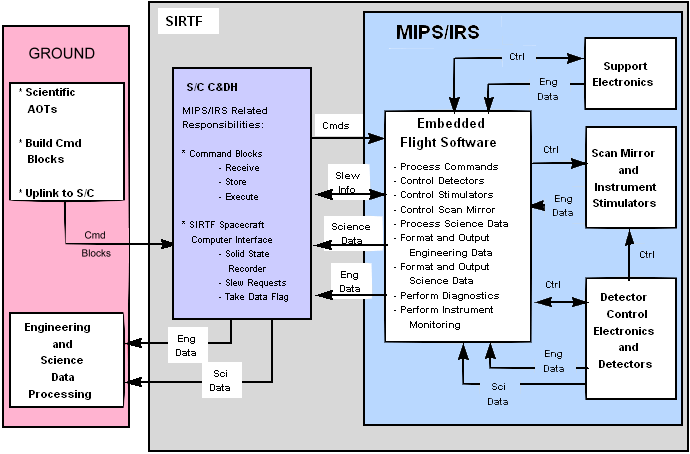The diagram below shows the flow of information to and from the MIPS instrument. As shown in the figure, operational parameters are converted into the appropriate command blocks at the ground station, which are then uplinked to SIRTF. Instrument specific commands are received and distributed by the spacecraft command and data handler (S/C C&DH). The spacecraft C&DH provides the interface between the SIRTF spacecraft and the SIRTF instruments. The spacecraft C&DH sends the MIPS specific commands on to the MIPS processor where they are interpreted and executed by the Control Section Flight Software. Engineering and science data are gathered by the various components of the MIPS embedded flight software and downlinked, via the spacecraft processor, to the ground for processing.

When power is applied to the main electronics of the MIPS instrument, the MIPS processor
begins execution of the boot state flight software. The functions for the boot state
software are:
To protect this basic upload and transfer capability, the flight software necessary to perform the boot state software functions resides in a write protected area of radiation hardened EEPROM. To reduce the complexity and increase the reliability of the boot state flight software, it has been written without incorporating the real-time operating system that is being utilized by the operate state flight software. The boot state flight software utilizes a basic cyclic executive to handle its operations. After the boot state software has copied the operate state software from EEPROM to EDAC RAM, the instrument may be commanded into the operate software state where instrument science activities can be performed. All instrument calibrations, science observations and instrument diagnostic activities are performed by the operate state software. To accomplish this, the operate state software supports the following tasks:
Multiple sequential observations may be performed while the instrument is in the operate state.
The Control Section Flight Software is written in the 'C' programming language and the operate state flight software utilizes the VxWorks Real-Time Operating System. The flight software was originally developed on a Motorola 603e PowerPC target processor, and will be ported to the Lockheed-Martin RAD-6000 flight processor for final integration and test. The PowerPC development environment is architecturally identical to the RAD-6000 environment with a much lower cost.
 |
 |
|